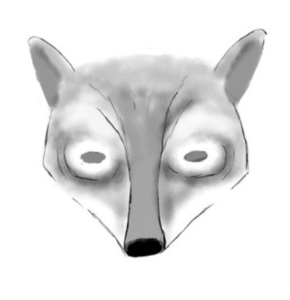If you’ve seen my other work, you may have noticed some drawings of these guys:

Along with humans, these creatures form the majority of sapient life on this planet. Descended from large procyonids (relatives of raccoons), they long ago adopted bipedalism and lost most of their fur. While they have had many different names in different places and at different times, we will call them the Golkh.
When designing a “sapient species,” speculative biology often isn’t just concerned with making a species that is sapient. What we want is a species with members that can interact with each other and the world around them, forming societies and creating new technologies. We aren’t just looking to make a species with the same level of cognition as humanity (a trait probably already shared with some cetaceans and possibly with other organisms) – we’re trying to make a species that can use that cognition to impose its will on the world.
Procyonids seem uniquely suited for this purpose. In particular, members of the genus Procyon, commonly known as raccoons, have many of the qualities that help with the development of this kind of sapience:
- They’re intelligent; studies have shown them to be quick learners and good at retaining learned information. (They also have an unusually high neuron density, something that has been proposed as a neuroanatomical indicator of intelligence.)
- They exhibit sociality.
- They have high manual dexterity, even without opposable thumbs
- And we can always give them opposable thumbs, or something that functions like them, later
- They’re generalist omnivores – a niche which Adrian Tchaikovsky in Children of Time argues is highly conducive to development of sapience
- While they don’t commonly use tools in the wild, they are adept at doing so in experimental conditions, suggesting that they have the capacity. (See Morton, F. Blake)
Given this, it’s surprising that procyonids aren’t more common as creatures chosen to evolve sentience in speculative biology. My personal theory is that they’re just too straightforward to be of interest to most speculative biologists. Cetaceans, a common choice, offer some unique challenges when it comes to developing societies: their underwater habitat makes developing the use of fire, and thus traditional metallurgy, impossible, and they lack appendages that are ideal for tool use. Insects, particularly eusocial ones, offer interesting social structures – either navigating how individuals work within the hive structure or how a hive itself can function as a sapient entity. Cephalopods, in addition to the sheer weirdness/coolness factor, also have an underwater mode of living as well as unusual neurology. But procyonids are already close enough to humans that creating a society out of them doesn’t present much of a challenge.
But that’s actually good for my purposes. The golkh aren’t supposed to be alien to humanity. Humans and golkh have been in contact since prehistory, and throughout history they’ve worked together, lived together and built civilisations together. This is only possible because the two species are so similar. They share potential habitats (both requiring air, not water, and both living above ground.) Their articulators (organs used to produce speech) are more or less the same. Their bodies end up similar enough that technology usable by a golkh should be usable by a human and vice versa. This means that humans don’t need special technology to communicate or live with golkh.
But humans and golkh do have differences, and, over millenia of close contact, these differences will become very obvious. This is part of what you have to consider when designing them. Minor details – slight differences in life cycle, anatomy, or even diet – can create larger differences in lifestyle and worldview. When considering a society that includes multiple species, which of these differences will cause rifts in the society? Which conflicting needs can be simultaneously met? Which different ideas can find a middle ground? And how will a society based on multiple species understand concepts like ethnicity? Nationhood? Personhood?
Of course, I’m not trying to answer these questions in this post. We still need to discuss the species itself. So, in the next post on the Golkh, I’m going to discuss their evolution – the creatures that they evolved from, and what pressures led them towards sapience.